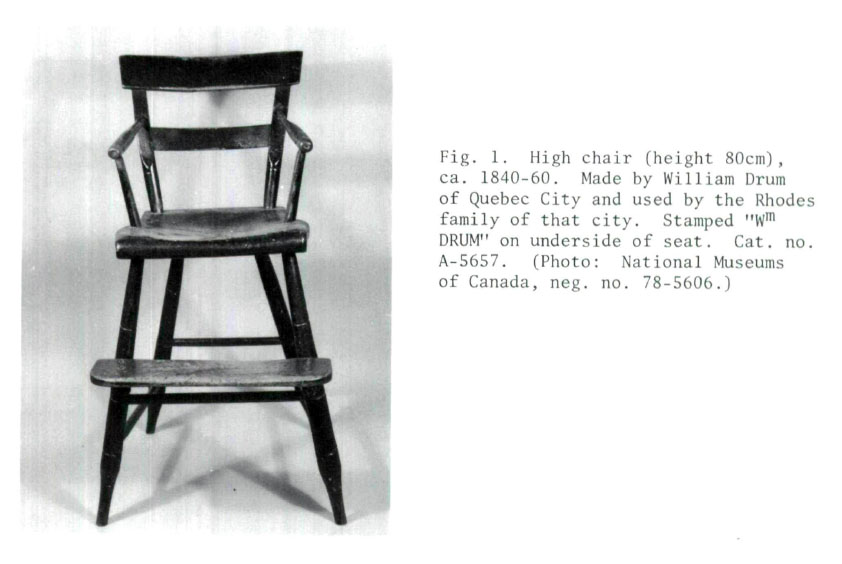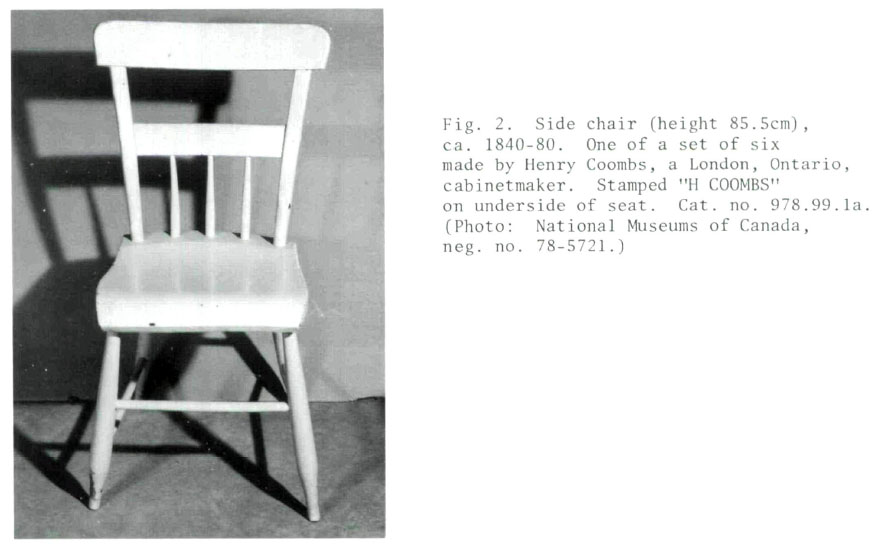Furniture in Public Collections in Canada / La Collection Nationale de Mobilier
National Museum of Man:
History Division
1 Approximately 1,500 pieces of furniture are among the holdings of the History Division of the National Museum of Man. The primary objective in the development of the collection is to trace and illustrate the history of furniture used in Canada, from the late eighteenth century to the present, through the acquisition of representative examples. This objective is in keeping with the mandate of the division to collect objects reflecting the social, economic, and material history of the non-indigenous peoples of Canada. In order to establish a sound basis for future research, an artifact' s history of use or manufacture is a primary consideration in its acquisition.
2 The furniture collection consists of material from a wide range of socio-economic levels and covers all regions of the country. The products of both the craft and industrial eras are well represented. Where possible, tools and patterns and copies of original photographs and documents having a bearing upon the furniture collected are also acquired. The Baker collection, described elsewhere in this issue, is a good example of one such acquisition. Geographically the collection is uneven in its representation. The division has strong collections of furniture from central Canada. Ontario holdings are especially important due to the large number of well-documented artifacts. However, neither the Atlantic nor the western provinces are well represented. Although work is continuing in both these directions, it is expected that these areas of the collection will continue at a disadvantage relative to the strong holdings from central Canada and to the collections housed in provincial and regional museums.
3 A small collection of 135 pieces, dating largely from 1840 to 1880, represents the province of New Brunswick. One of the most impressive of these pieces is a large, mahogany mantelpiece with surrounding shelves and glazed cabinets, donated to the museum in 1966. The mantelpiece is believed to have been designed by John D. Howe of Saint John in 1883 and carved by an associate, Frederick Dodge. A more recent New Brunswick acquisition includes a number of pieces of typical Victorian parlour furniture, used in Saint John and perhaps made in that city, as well as a handsome pair of late eighteenth-century, Chippendale-style side chairs, brought to the province from Boston, Massachussetts, in 1872.
4 Newfoundland and Prince Edward Island are each represented by only a handful of objects. Among the thirteen items from Newfoundland are pieces attributed to three native craftsmen — Richard Lawton of King's Cove, William Lacey of Bareneed, and Aaron Forsey of Grand Bank. Of special note among Prince Edward Island holdings is a recent acquisition, a set of six cane-seated chairs with a well-documented history of use in the province since ca. 1855. Nova Scotia is represented by a small collection of approximately fifty objects. These include a number of marked or labelled nineteenth-century chairs.
5 The craftsmanship of Quebec is well demonstrated by a representative collection of close to 400 pieces. Most types of furniture in use during the eighteenth and nineteenth centuries are included, although not all periods and styles are evenly represented. Of particular interest are those artifacts whose original finish remains intact, a group which includes several spectacular armoires from the late eighteenth and early nineteenth centuries. Also of interest is an important collection of approximately ninety-five chairs, ranging from the classic upholstered armchair with os-de-mouton turnings to rustic, slat-back rockers, lightweight convent chairs with rush seats, and a number of late nineteenth-century chairs which reflect a fascinating combination of traditions and influences.
 Display large image of Figure 1
Display large image of Figure 16 The bulk of a small collection of material from the four western provinces was acquired at an early date and has not been well documented. Among the articles of known manufacture are those from the Villarboito firm of St. Boniface, Manitoba, and two Winnipeg companies, D. Cramer and Sons and D. Shaw.
7 The Ontario collection consists of approximately 865 objects, ranging from beds and bookcases to tables and washstands. The collection spans the period 1780 to 1930, although the bulk of the material dates between 1840 and 1890. A large number of these artifacts retain the label or signature of the craftsman or factory involved in their production. Information concerning the original owner or user has also frequently been recorded. The collection of cupboards from southern Ontario is particularly fine. Nineteenth-century beds, chests of drawers, and chairs are also well represented. The division has started to collect early twentieth-century furniture and expects to continue steadily in this direction. Special emphasis will be placed on the products of Ontario's own furniture industry, in particular larger companies such as the Knechtel Furniture Company whose products were shipped from Newfoundland to British Columbia.
 Display large image of Figure 2
Display large image of Figure 28 The furniture collection provides a wide range of possibilities for social, cultural, and material history studies. Cross-reference files include entries under article name, date, maker's and original owner's names, and region of use and manufacture. Catalogue cards and document files provide further details on individual artifacts. Whenever possible, researchers are permitted to examine the pieces themselves. Basic information on the collection has been entered in the National Inventory, a computerized data bank. This system will eventually include details of interest to researchers, replacing the manual files referred to above and providing access from associate museums across the country.
 Display large image of Figure 3
Display large image of Figure 39 A catalogue of the furniture collection is currently in the planning stage as are a number of smaller publications on various aspects of the collection. Black and white photographs of many of the artifacts are available for a nominal charge from the Photographic Section, Design and Technical Services, National Museums of Canada. Persons desiring further information concerning the furniture collection of the History Division are asked to contact Christine Grant at the History Division, National Museum of Man, Ottawa K1A 0M8.